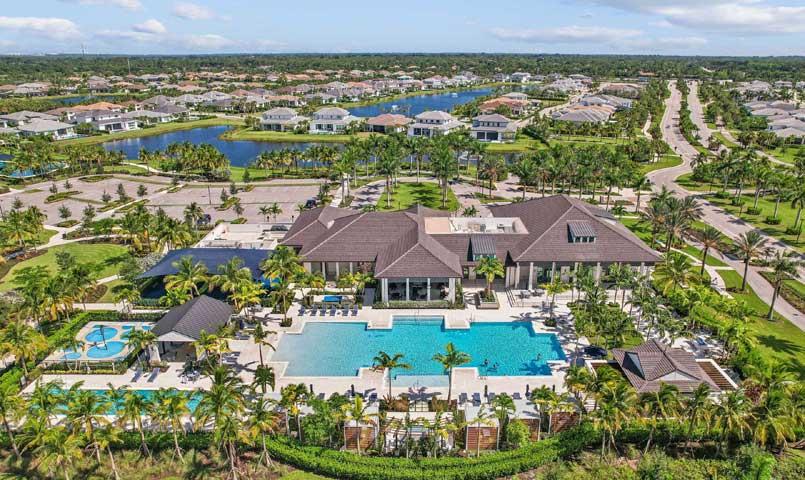by Robert Borges on November 12, 2024
For countless snowbirds, Florida has long been the ultimate winter retreat, thanks to its sunny climate, welcoming atmosphere, and relatively affordable cost of living. The state’s snowbird season spans October to April, perfectly timed to help visitors escape the chilly months in northern states. Whether you're dreaming of oceanfront views, serene lake communities, or active urban life, "Snowbird Florida" offers diverse regions that cater to every lifestyle, along with an abundance of 55 plus communities to call home during those otherwise chilly months. Here’s a guide to Florida’s top snowbird destinations, plus tips to make the most of your winter in the Sunshine State.
Southeast Florida

Southeast Florida is synonymous with vibrant energy and gorgeous Atlantic beaches, making it a prime location for snowbirds seeking warm coastal breezes and an exciting lifestyle. For those craving the bustling Miami metro area, the scenic Treasure and Gold Coasts, Palm Beach Gardens golf communities, and everything in between, this region offers year-round outdoor fun, from snorkeling and deep-sea fishing to exploring lush parks and historic sites. Southeast Florida also boasts a multicultural dining scene, shopping, and entertainment that rivals any major city. With winter temperatures comfortably in the 70s, this subtropical paradise is ideal for snowbirds wanting to combine relaxation with urban excitement.
Explore communities in Southeast Florida
Southwest Florida

If a sunset over the Gulf of Mexico and laid-back coastal charm is calling, Southwest Florida could be your perfect snowbird Florida escape. Known as the Florida Suncoast, this area is home to captivating beaches, iconic resorts, and charming coastal towns. Naples and Fort Myers offer a balance of Southwest Florida communities near upscale amenities, shopping, and dining, while Sanibel and Captiva Islands are renowned for their pristine, shell-strewn beaches and nature preserves. With winter highs in the mid-70s, Southwest Florida combines mild temperatures with the perks of sophisticated and relaxed living.
Explore communities in Southwest Florida
Central Florida

Central Florida is a dream for snowbirds who want a mix of family-friendly attractions and quiet lakeside living. This area isn’t just home to Walt Disney World and Universal Studios but also to nature-rich lakes, championship golf courses, and the scenic Atlantic coastline. Central Florida’s winter temperatures stay in the comfortable range of 72 to 74 degrees, making it ideal for outdoor activities like golf, fishing, or simply strolling through the region’s beautiful parks. The area also offers easy access to top shopping, dining, and cultural events without the hustle of major metro areas.
Explore communities in Central Florida
Northeast Florida

Northeast Florida is a haven for history lovers and beachgoers alike. This region, home to America’s oldest city, St. Augustine, and its largest city, Jacksonville, offers both historic charm and modern conveniences. Snowbirds can spend their winters exploring the rich colonial architecture of St. Augustine, basking on quiet beaches, or enjoying Jacksonville’s urban scene. With average winter temperatures in the mid-60s, Northeast Florida provides mild weather that’s perfect for sightseeing, outdoor dining, and golf.
Explore communities in Northeast Florida
Florida Panhandle

For snowbird Florida enthusiasts craving a peaceful atmosphere and “Old Florida” charm, the Florida Panhandle’s Emerald and Forgotten Coasts offer an ideal blend of relaxation and scenic beauty. Known for its sugary white beaches and emerald waters, the Panhandle provides a serene alternative to Florida’s more populated regions. The area’s historic towns, such as Pensacola and Tallahassee, offer a slower pace with plenty of local charm and Southern hospitality. Winter temperatures average in the low to mid-60s, perfect for long beach walks, fishing, and exploring local history.
Explore communities in the Florida Panhandle
Tips for Snowbirds Living in the Sunshine State
Once you've found your ideal snowbird haven, these tips will help you make the most of your winter escape in Florida:
- Plan Ahead for Housing: Snowbird season is peak time in Florida, so securing a winter rental or buying a home early can ensure you get your top choice. Many communities offer seasonal rental options for snowbirds.
- Health Care Access: Research local healthcare providers and facilities, particularly if you need ongoing medical care. Florida’s healthcare system is extensive, but finding providers before you arrive will help you transition smoothly.
- Transportation Considerations: Florida is vast, and each region has unique transportation options. If you're in a city like Miami or Orlando, public transportation and rideshares may be plentiful. In coastal or rural areas, a car might be essential.
- Join Local Snowbird Clubs: Many Florida regions have social clubs specifically for snowbirds, offering a great way to meet other seasonal residents and enjoy organized activities, from beach outings to group trips.
- Adjust to Florida’s Weather Patterns: While winter is mild, Florida’s tropical climate means occasional rain showers. Keep an umbrella handy, and be mindful of sun protection during those beautiful, sunny days.
- Stay Active: Florida’s mild winters and countless outdoor activities make it easy to stay active. From golf and tennis to water aerobics and beach walks, the state is full of options to keep you moving and healthy.
- Learn About Local Events and Festivals: Winter in Florida is festival season! Enjoy everything from seafood festivals to art fairs that showcase Florida’s unique culture and cuisine.
Choosing a Florida snowbird destination lets you escape the cold and embrace a warm, vibrant, and active winter lifestyle. Whether you’re drawn to the beaches, historic towns, or bustling cities, Florida has something for every snowbird. Be sure to explore PrivateCommunities.com for more information on the definition of active adult communities before you decide on those that may be the best fit for your snowbird advenures.
